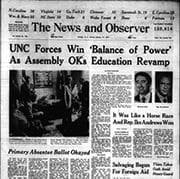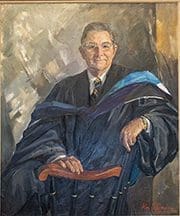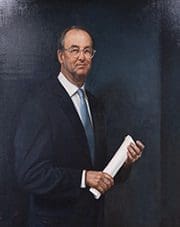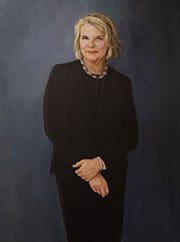
North Carolina Gov. Robert Scott launches an effort to restructure the state’s public higher education system. His efforts cause friction, particularly among leaders of the six-campus Consolidated University of North Carolina. Prominent figures like UNC President William C. Friday are resistant against the type of sweeping consolidation endorsed by Scott, saying the restructuring could reverse successes already achieved by UNC. But legislators welcome Scott’s proposal as an opportunity to alleviate the pressure of competing budgetary demands from remaining independent public colleges during a period of expansion and ambition. They also support consolidation as a means to develop a statewide plan for higher education, deal with inequities in funding, and eliminate duplication of higher education programs.
During a buffet dinner at the Executive Mansion, Gov. Scott convenes an audience of 40 UNC trustees and Board of Higher Education members. Scott appeals to the trustees directly, telling them it is their responsibility to establish policy and provide leadership. The governor says he favors a “new structure” different from both the university and the BHE, one that would require “scrambling a whole new batch of eggs.” By late December both the BHE and UNC Board of Trustees agree to cooperate with the governor.
Source: “William Friday: Power, Purpose, & American Higher Education” by William Link
 After several standoffs and much political maneuvering between Scott and Friday and various factions, the General Assembly passes legislation consolidating the University of North Carolina into a 16-campus system. Under the legislation, 10 campuses are added, campus boards of trustees are retained, and a new 32-member UNC Board of Governors is created to govern the system.
After several standoffs and much political maneuvering between Scott and Friday and various factions, the General Assembly passes legislation consolidating the University of North Carolina into a 16-campus system. Under the legislation, 10 campuses are added, campus boards of trustees are retained, and a new 32-member UNC Board of Governors is created to govern the system.
“In order to foster the development of a well-planned and coordinated system of higher education, to improve the quality of education, to extend its benefits and to encourage an economical use of the State’s resources, the University of North Carolina is hereby redefined in accordance with the provisions of this Article.
“The Board of Trustees of the University of North Carolina is hereby redesignated, effective July 1, 1972, as the “Board of Governors of the University of North Carolina.” – North Carolina General Statutes, Chapter 116, Article 1, The University of North Carolina
Gov. Scott remarked, “Mr. President, Mr. Speaker, members of the General Assembly, North Carolinians all: Let us enlarge our understanding and broaden our vision. By adopting this blueprint, we will not be surrendering our traditions, our ties, our loyalties. We can retain them, yet at the same time we can rise about our sectionalism and our provincialism.
“Let us look beyond the trees and behold the forest – the forest of all of higher education. Let us nurture it and manage it wisely, keeping it forever green, forever growing.”
 The Planning Committee that was a precursor to the Board of Governors chooses Friday to lead the new system.
The Planning Committee that was a precursor to the Board of Governors chooses Friday to lead the new system.
Despite friction with Gov. Scott during the consolidation process, Friday is steadfast in his role as an advocate for the UNC System and American higher education, leading all 16 campuses through a period of growth and increased stability. “Friday fought this thing as hard as he knew how,” recalled Scott, who had presented his former opponent’s nomination to the board. “But when it was done and over, he took the lead and he made it work. I doubt that anyone else could have made it work except for him. He had the respect, integrity, prestige and knowledge essential for that enormous task.”
Source: “Reorganizing Higher Education in North Carolina” by Barbara Solow, published by the North Carolina Center for Public Policy Research
Friday grew up in Dallas, N.C., and entered Wake Forest College before transferring to North Carolina State College, now known as North Carolina State University. There he earned a bachelor’s degree in textile engineering and, following graduation, served in the U.S. Navy during World War II. After the war, he entered law school at the University of North Carolina at Chapel Hill, where he earned his degree in 1948. Friday served as an assistant to University of North Carolina President Gordon Gray from 1951 to 1955. Friday began his own career as president in 1956 and served in that role until 1986. His 30-year-career was marked by the progress of the state’s public universities, but also by his ability to manage challenges of campus unrest and political controversies. Friday would become a beloved figure in his state and a revered statesman in American higher education.
System institutions include Appalachian State University, East Carolina University, Elizabeth City State University, Fayetteville State University, North Carolina A&T State University, North Carolina Central University, North Carolina State University, UNC Asheville, UNC-Chapel Hill, UNC Charlotte, UNC Greensboro, UNC Pembroke, UNC School of the Arts, UNC Wilmington, Western Carolina University, and Winston-Salem State University.
 Although the ECU medical school had been authorized by the legislature in 1965, it only existed as a one-year feeder program to UNC-Chapel Hill’s medical school. For years, Chancellor Leo Jenkins had fought for a full-fledged medical school to train primary care physicians, but the idea encountered strong opposition from UNC-Chapel Hill supporters and others who thought the endeavor was too expensive. In 1975, the General Assembly appropriates the money for facilities and the expansion of the school into a four-year program.
Although the ECU medical school had been authorized by the legislature in 1965, it only existed as a one-year feeder program to UNC-Chapel Hill’s medical school. For years, Chancellor Leo Jenkins had fought for a full-fledged medical school to train primary care physicians, but the idea encountered strong opposition from UNC-Chapel Hill supporters and others who thought the endeavor was too expensive. In 1975, the General Assembly appropriates the money for facilities and the expansion of the school into a four-year program.
NCSSM is founded by former North Carolina Gov. James B. Hunt Jr., Duke University President and former Gov. Terry Sanford, and academician and author John Ehle. All three see the institution as an investment in North Carolina’s human and intellectual capital, and a means to economic progress.
 President C.D. Spangler Jr., brings a businessman’s sensibilities to his role as leader of the state’s public higher education system. Spangler steadfastly believes in every North Carolinian’s constitutional right to affordable public higher education. During his tenure, he refuses a presidential salary, famously opting to instead donate the money to the System’s campuses.
President C.D. Spangler Jr., brings a businessman’s sensibilities to his role as leader of the state’s public higher education system. Spangler steadfastly believes in every North Carolinian’s constitutional right to affordable public higher education. During his tenure, he refuses a presidential salary, famously opting to instead donate the money to the System’s campuses.
Born in Charlotte, Spangler spent his formative years as a student at Dilworth Elementary and Alexander Graham before attending Woodberry Forest School, a boy’s prep school in Virginia. He enrolled at UNC-Chapel Hill for his undergraduate degree, going on to Harvard Business School for graduate studies. A billionaire businessman, Spangler devoted much of his career to public education, serving as vice chair of the Charlotte-Mecklenburg School Board in the 1970s and helping steer the district through a tumultuous period of integration. He also chaired the State Board of Education before going on to become president of the UNC System in 1986.
 The landmark is created to honor Frederick Law Olmsted, the Father of American Landscape Architecture and the designer of several projects at the nearby Biltmore Estate. Olmsted’s design for an arboretum at the Biltmore was never realized, but inspired the design of the North Carolina Arboretum.
The landmark is created to honor Frederick Law Olmsted, the Father of American Landscape Architecture and the designer of several projects at the nearby Biltmore Estate. Olmsted’s design for an arboretum at the Biltmore was never realized, but inspired the design of the North Carolina Arboretum.
North Carolina Governor and NC State alumnus James B. Hunt Jr., allocate the initial 355-acre parcel of land for the university’s Centennial Campus. The land had previously been part of the Dorothea Dix hospital.
“I speak for all of us who could not afford to go to Duke, and would not have, even if we could have afforded it,” says UNC alumnus and journalist Charles Kuralt, joking before a cheering crowd in Kenan Stadium. Kuralt delivers his address before special guests like President Bill Clinton and Gov. Jim Hunt.
“What is it that binds us to this place as no other?” Kuralt asks the crowd. “It is not the well or the bell or the stone walls. Or the crisp October nights or the memory of dogwoods blooming. Our loyalty is not only to William Richardson Davie, though we are proud of what he did 200 years ago today. Not even to Dean Smith, though we are proud of what he did last March. No, our love for this place is based on the fact that it is, as it was meant to be, the University of the people.”
 Upon her election as the first female and first non-North Carolinian UNC President, Broad strategically focuses on doubling overall minority enrollment and leads efforts to establish a need-based financial aid program for in-state students.
Upon her election as the first female and first non-North Carolinian UNC President, Broad strategically focuses on doubling overall minority enrollment and leads efforts to establish a need-based financial aid program for in-state students.
The daughter of two public school teachers, Molly Corbett Broad was born in Pennsylvania and earned her undergraduate degree from Syracuse University and her master’s degree in economics from Ohio State University. Broad began her career at SU and held several positions at the institution before serving as chief executive officer for Arizona’s three-campus university system and then as an executive at the California State University System.
The health care system, established by the General Assembly, originally consists of UNC Hospitals and clinical care programs maintained by the UNC School of Medicine.
 North Carolinians vote overwhelmingly in favor of the nation’s largest ever higher education bond. The measure authorizes the issue of $3.1 billion in bonds for improvements to the UNC System, community colleges, and facilities of the UNC Health Care System.
North Carolinians vote overwhelmingly in favor of the nation’s largest ever higher education bond. The measure authorizes the issue of $3.1 billion in bonds for improvements to the UNC System, community colleges, and facilities of the UNC Health Care System.

 Bowles, an investment banker from Charlotte, is elected president of the UNC System. The guiding message of Bowles’ presidency is “Low tuition without high-quality education is no bargain for anyone.” He puts this into practice by keeping tuition low, cutting costs, and strengthening the university’s focus on serving the needs of the state. Bowles’ fiscal acumen is especially critical in navigating the university through the Great Recession during which he maintained a laser focus on preserving funding for the university’s core mission. He serves as president from 2005 to 2011.
Bowles, an investment banker from Charlotte, is elected president of the UNC System. The guiding message of Bowles’ presidency is “Low tuition without high-quality education is no bargain for anyone.” He puts this into practice by keeping tuition low, cutting costs, and strengthening the university’s focus on serving the needs of the state. Bowles’ fiscal acumen is especially critical in navigating the university through the Great Recession during which he maintained a laser focus on preserving funding for the university’s core mission. He serves as president from 2005 to 2011.
Born and raised in Greensboro, Erskine Bowles graduated from UNC and received his M.B.A. from Columbia University in New York. His storied career includes service in the U.S. Coast Guard, work in investment banking and venture capital, and public service as part of President Bill Clinton’s administration. In 1991, Bowles worked as administrator of Clinton’s Small Business Administration. In 1993, he moved to the White House to work as deputy chief of staff and later chief of staff. He also served as a member of the president’s cabinet, the National Security Council, and the National Economic Council.
 Ross takes his seat as the fifth president of UNC, focusing his strategic plan on goals related to adult educational attainment, online education, financial efficiency, and research. He serves from 2011 to 2016.
Ross takes his seat as the fifth president of UNC, focusing his strategic plan on goals related to adult educational attainment, online education, financial efficiency, and research. He serves from 2011 to 2016.
Born and raised in Greensboro, Thomas Ross received his bachelor’s degree in political science from Davidson College and graduated with honors from the UNC-Chapel Hill School of Law. Prior to becoming president of the UNC System, Ross served as president of Davidson College, executive director of the Z. Smith Reynolds Foundation, director of the North Carolina Administrative Office of the Courts, and a Superior Court judge, among many other roles.
In a first-ever event, the University of North Carolina presidents meet to celebrate the 40th anniversary of the legislation that brought all 16 of North Carolina’s public universities into the UNC System. The show features Former Governor Jim Holshouser, who leads the candid talk with William Friday, C.D. Spangler Jr., Molly Corbett Broad, Erskine Bowles, and Tom Ross.
An Evening with Five UNC Presidents from UNC System on Vimeo.

With a fall enrollment of 10,734 students, N.C. A&T becomes the largest HBCU in the nation.
In the first statewide bond passed since 2000, two-thirds of North Carolina voters support borrowing $2 billion for campus construction and infrastructure. Two-thirds of the money goes toward public universities and community colleges, specifically supporting buildings for science, technology, engineering, mathematics, and health care.
 Margaret Spellings becomes the sixth president of the UNC System in March 2016, launching a five-pronged strategic plan focused on the areas of access, affordability, student success, economic impact, and excellent and diverse institutions.
Margaret Spellings becomes the sixth president of the UNC System in March 2016, launching a five-pronged strategic plan focused on the areas of access, affordability, student success, economic impact, and excellent and diverse institutions.
Born in Michigan, Spellings grew up in Texas and graduated from the University of Houston with a bachelor’s degree in political science. Spellings served as U.S. Secretary of Education under President George W. Bush, leading the Education Department from 2005 to 2009. Prior to joining the UNC System, Spellings served as president of the George W. Bush Presidential Center in Dallas, Texas.
Launched in Fall 2016 as part of the UNC System’s strategic plan, in-state undergraduate students on all UNC campuses pay the same tuition rate until they graduate, provided they are enrolled for consecutive fall and spring semesters in their university and graduate in four years. For first-year students, that amounts to eight consecutive semesters.
FSU is a constituent institution of the University of North Carolina System and the second-oldest public institution of higher education in the state. FSU offers nearly 60 degrees at the bachelor’s, master’s, and doctoral levels.
The General Assembly passes a landmark plan to invest in state undergraduate enrollment at Elizabeth City State University, UNC Pembroke, and Western Carolina University. The groundbreaking low-tuition program ensures $500 per semester in-state tuition, inspiring a surge in enrollment at all three institutions.

Peter Hans is the seventh president of the University of North Carolina System and a lifelong supporter of public higher education. As a first-generation college graduate from rural North Carolina, he knows the value of access to an affordable, high-quality education for everyone.
Since taking the helm of the UNC System in August of 2020, President Hans has advocated for adult learners, fought to lower costs for students, championed the renovation of facilities in need of repair, and steered the state’s public universities through the challenges of the pandemic. He came to the role after serving as the ninth president of the North Carolina Community College System, where he oversaw improvements in completion rates, increased public funding and private giving, and growth in business partnerships.
Strengthening ties between community colleges and universities remains a core goal for President Hans. He has served on the boards of both systems, having been elected by the legislature to the State Board of Community Colleges (1997-2003) and the UNC Board of Governors (2003-2015). As Chairman of the BOG from 2012 to 2014, Hans pushed for streamlined transfer agreements, greater focus on online education, and identifying administrative efficiencies that could be re-invested in student support.
Earlier in his career, he served as senior policy advisor to three members of the United States Senate, counseled the private sector on public affairs at one of the state’s largest law firms, and supported UNC System President Margaret Spellings on key policy initiatives.
President Hans grew up in the small North Carolina towns of Southport on the coast and Hendersonville in the mountains. He earned a Bachelor of Arts degree from UNC-Chapel Hill and a Master of Liberal Arts in Extension Studies from Harvard University.
The UNC System marks 50 years since the legislation that created the 16-university system.

UNC System constituents gather at N.C. State University to celebrate the 50th anniversary and the inauguration of President Peter Hans as the seventh president of the consolidated System.